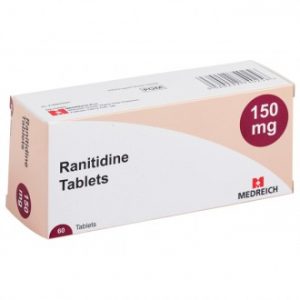OTC Antacids Medication Examples
The Most Famous 2 drugs for Treatment of acidity and stomach ulcers are:
1- Famotidine 💊
2- Ranitidine 💊
Famotidine
- Brand Names: Pepcid
- Therapeutic Category: Histamine H2 Antagonist, Antacids
- Dosage Forms: Oral Tablet, Solution/ Injection Antacids
- Use: Labeled Indications: Gastroesophageal reflux disease/ Heartburn/ Peptic ulcer disease
- Off Label Indication: Aspiration prophylaxis in patients undergoing anesthesia/ Chronic spontaneous urticarial/ Stress ulcer prophylaxis in select critically ill patients/ Mastocytosis
- Dosing : Adult Heartburn, mild intermittent symptoms: Oral: 10 to 20 mg up to twice daily when needed (maximum: 40 mg/day); may also be taken 10 to 60 minutes before meals or beverages that cause heartburn (maximum: 40 mg/day).
- Pediatric: Infants <3 months: 0.5 mg/kg/dose once daily for up to 8 weeks; if not effective after 2 weeks, increasing to 1 mg/kg/dose once daily
- Infants ≥3 months, Children, and Adolescents ≤16 years: Initial: 0.5 mg/kg/dose twice daily; maximum dose: 40 mg/dose
- Dose Adjustments
- Renal Impairment:. CrCl 30 to 60 mL/minute: Maximum dose: 20 mg once daily or 40 mg every other day
- CrCl <30 mL/minute: Maximum dose: 20 mg every other day or 10 mg once daily
- Hepatic Impairment: No dosage adjustment for Antacids
- Adverse Drug Interaction:
Agitation, Headache, dizziness, Diarrhea - Pharmacodynamics/Kinetics:
- Onset of action: Within 1 hour
- Bioavailability: Oral: 40% to 45%
- Time to peak, serum: Within 1 to 3 hours
- Duration : 10 to 12 hours
- Important Notes:
- Prolonged QT interval has been reported in patients with moderate to severe renal impairment.
- Pregnancy & Lactation: pregnancy category B drug / present in breast milk
- Drug safety issue:
Famotidine may be confused with FLUoxetine, furosemide
Ranitidine
- Brand Names: Zantac
- Therapeutic Category: Histamine H2 Antagonist, Antacids
- Dosage Forms: Oral Capsule/ Syrup /Tablet, Solution/ Injection Antacids
- Use: Labeled Indications: Gastroesophageal reflux disease/ Heartburn/ Peptic ulcer disease
- Off Label Indication: Anaphylaxis or severe infusion reaction/ Aspiration prophylaxis in patients undergoing anesthesia/ Chronic spontaneous urticarial/ Stress ulcer prophylaxis in select critically ill patients
- Dosing : Adult Oral: 75 mg twice daily as needed; if symptoms persist after 2 to 4 weeks, increase to 150 mg twice daily for 2 weeks
- Pediatric: Infants, Children, and Adolescents ≤16 years: Oral: 5 to 10 mg/kg/day divided twice daily; maximum dose: 150 mg/dose
- Adolescents >16 years: Oral Treatment: 150 mg 4 times daily/ Maintenance: 150 mg twice daily
- Dose Adjustments
- Renal Impairment:. CrCl <50 mL/minute:Oral: 150 mg every 24 hours
- Hepatic Impairment: No dosage adjustment for Antacids
- Adverse Drug Interaction:
bradycardia/ Agitation, confusion, dizziness, depression, drowsiness - Pharmacodynamics/Kinetics:
- Onset of action: Oral: 12 to 72 hours
- Bioavailability: Oral tablets: 50%
- Time to peak, serum: Oral: 2 to 3 hours
- Half-life elimination: Oral: Normal renal function: 2.5 to 3 hours
- Important Notes:
- Hepatic effects: Elevation in ALT levels has occurred with higher doses (≥100 mg) or prolonged IV therapy (≥5 days)
- Rare cases of reversible confusion have been associated with ranitidine; usually elderly or severely ill patients
- Pregnancy & Lactation: pregnancy category B drug / present in breast milk
- Drug safety issue:
- RaNITIdine may be confused with amantadine, riMANTAdine
- Zantac may be confused with Xanax, Zarontin, Zofran, ZyrTEC
Read More
- Antimicrobial Stewardship School
- Sepsis Training Program
- Download Pocket Guide for Antibiotic Pharmacotherapy Book
- Microbiology Course | ABC Bacteria
- Infectious Disease E-News | FREE Subscription
- ABC antimicrobials | Know all about the Antimicrobials
- Road Map to Antimicrobial Stewardship Training Program
- Register Now in FADIC Clinical Research School
- FADIC Drug Information Fellowship
- Buy FADIC Toolkit for Writing Research to Write a Great Research Paper
- Read 10 Skills You Must Learn to Make a Research via Google Scholar in Arabic
- The FADIC Online Continuous Medical Improvement Programs & Mini-Courses.
- Check Now FADIC Book store and Buy books in different specialties.
- Watch Now FADIC TV to Keep your self Updated.
- FADIC Podcast focusing on varieties of pharmacist perspectives in different specialties.
- Subscribe Now in FADIC 2020 Daily News (FNN) and Keep Updated.
- Check Now about Coronavirus Resource Information Center.

 Log in
Log in Sign up
Sign up



